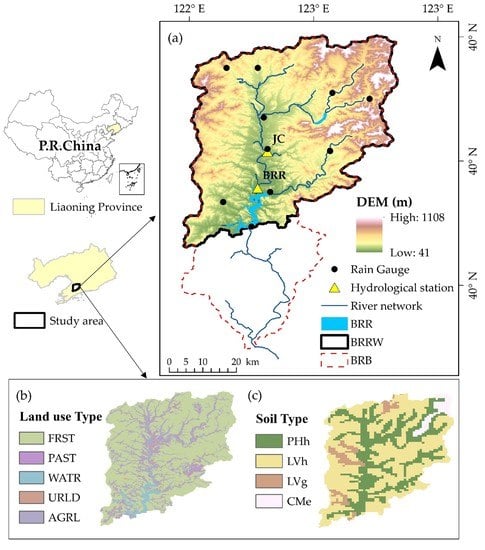Assessment of TMPA 3B42V7 and PERSIANN-CDR in Driving Hydrological Modeling in a Semi-Humid Watershed in Northeastern China
Abstract
1. Introduction
2. Materials and Methods
2.1. Study Area
2.2. Precipitation Datasets
2.2.1. Gauge Precipitation Data
2.2.2. Satellite Precipitation Products
2.3. Accuracy Assessment of Satellite Precipitation Products
2.4. SWAT Model Application
3. Results and Discussion
3.1. Evaluation of Satellite Precipitation Products
3.1.1. Daily Precipitation
3.1.2. Monthly Precipitation
3.2. Evaluation of Streamflow Simulation
3.2.1. Streamflow Simulation
3.2.2. Performance under Different Flow Levels and Hydrological Years
3.3. Evaluation of Hydrologic Process Simulation
3.3.1. Water Balance
3.3.2. Annual and Monthly Runoff Distributions
4. Conclusions
Author Contributions
Funding
Acknowledgments
Conflicts of Interest
References
- Masih, I.; Maskey, S.; Uhlenbrook, S.; Smakhtin, V. Assessing the impact of areal precipitation input on streamflow simulations using the SWAT model. J. Am. Water Resour. Assoc. 2011, 47, 179–195. [Google Scholar]
- Michaelides, S.; Levizzani, V.; Anagnostou, E.; Bauer, P.; Kasparis, T.; Lane, J.E. Precipitation: Measurement, remote sensing, climatology and modeling. Atmos. Res. 2009, 94, 512–533. [Google Scholar]
- Xu, H.; Xu, C.; Chen, H.; Zhang, Z.; Li, L. Assessing the influence of rain gauge density and distribution on hydrological model performance in a humid region of China. J. Hydrol. 2013, 505, 1–12. [Google Scholar]
- Deng, P.; Zhang, M.; Bing, J.; Jia, J.; Zhang, D. Evaluation of the GSMaP_Gauge products using rain gauge observations and SWAT model in the Upper Hanjiang River Basin. Atmos. Res. 2019, 219, 153–165. [Google Scholar]
- Yu, Z.; Wu, J.; Chen, X. An approach to revising the climate forecast system reanalysis rainfall data in a sparsely-gauged mountain basin. Atmos. Res. 2019, 220, 194–205. [Google Scholar]
- Mei, Y.; Nikolopoulos, E.I.; Anagnostou, E.N.; Borga, M. Evaluating Satellite Precipitation Error Propagation in Runoff Simulations of Mountainous Basins. J. Hydrometeorol. 2016, 17, 1407–1423. [Google Scholar]
- Yuan, F.; Zhang, L.; Win, K.; Ren, L.; Zhao, C.; Zhu, Y.; Jiang, S.; Liu, Y. Assessment of GPM and TRMM Multi-Satellite Precipitation Products in Streamflow Simulations in a Data-Sparse Mountainous Watershed in Myanmar. Remote Sens. 2017, 9, 302. [Google Scholar]
- Tan, J.; Petersen, W.A.; Tokay, A. A Novel Approach to Identify Sources of Errors in IMERG for GPM Ground Validation. J. Hydrometeorol. 2016, 17, 2477–2491. [Google Scholar]
- Bitew, M.M.; Gebremichael, M. Assessment of satellite rainfall products for streamflow simulation in medium watersheds of the Ethiopian highlands. Hydrol. Earth Syst. Sci. 2011, 15, 1147–1155. [Google Scholar]
- Li, X.; Zhang, Q.; Xu, C. Suitability of the TRMM satellite rainfalls in driving a distributed hydrological model for water balance computations in Xinjiang catchment, Poyang lake basin. J. Hydrol. 2012, 426–427, 28–38. [Google Scholar]
- Zhang, Z.; Tian, J.; Huang, Y.; Chen, X.; Chen, S.; Duan, Z. Hydrologic Evaluation of TRMM and GPM IMERG Satellite-based Precipitation in a Humid Basin of China. Remote Sens. 2019, 11, 431. [Google Scholar] [CrossRef]
- Yu, M.; Chen, X.; Li, L.; Bao, A.; De la Paix, M.J. Streamflow simulation by SWAT using different precipitation sources in large arid basins with scarce raingauges. Water Resour. Manag. 2011, 25, 2669. [Google Scholar] [CrossRef]
- Himanshu, S.K.; Pandey, A.; Patil, A. Hydrologic Evaluation of the TMPA-3B42V7 Precipitation Data Set over an Agricultural Watershed Using the SWAT Model. J. Hydrol. Eng. 2018, 23, 5018003. [Google Scholar] [CrossRef]
- Zhu, Q.; Xuan, W.; Liu, L.; Xu, Y. Evaluation and hydrological application of precipitation estimates derived from PERSIANN-CDR, TRMM 3B42V7, and NCEP-CFSR over humid regions in China. Hydrol. Process. 2016, 30, 3061–3083. [Google Scholar] [CrossRef]
- Li, D.; Christakos, G.; Ding, X.; Wu, J. Adequacy of TRMM satellite rainfall data in driving the SWAT modeling of Tiaoxi catchment (Taihu lake basin, China). J. Hydrol. 2018, 556, 1139–1152. [Google Scholar] [CrossRef]
- Vu, T.; Li, L.; Jun, K. Evaluation of Multi-Satellite Precipitation Products for Streamflow Simulations: A Case Study for the Han River Basin in the Korean Peninsula, East Asia. Water 2018, 10, 642. [Google Scholar] [CrossRef]
- Tan, M.; Samat, N.; Chan, N.; Roy, R. Hydro-Meteorological Assessment of Three GPM Satellite Precipitation Products in the Kelantan River Basin, Malaysia. Remote Sens. 2018, 10, 1011. [Google Scholar] [CrossRef]
- Beck, H.E.; Vergopolan, N.; Pan, M.; Levizzani, V.; van Dijk, A.I.J.M.; Weedon, G.P.; Brocca, L.; Pappenberger, F.; Huffman, G.J.; Wood, E.F. Global-scale evaluation of 22 precipitation datasets using gauge observations and hydrological modeling. Hydrol. Earth Syst. Sci. 2017, 21, 6201–6217. [Google Scholar] [CrossRef]
- Guo, H.; Chen, S.; Bao, A.; Hu, J.; Gebregiorgis, A.; Xue, X.; Zhang, X. Inter-Comparison of High-Resolution Satellite Precipitation Products over Central Asia. Remote Sens. 2015, 7, 7181–7211. [Google Scholar] [CrossRef]
- Muhammad, E.; Muhammad, W.; Ahmad, I.; Muhammad Khan, N.; Chen, S. Satellite precipitation product: Applicability and accuracy evaluation in diverse region. Sci. China Technol. Sci. 2020, 63, 819–828. [Google Scholar] [CrossRef]
- Alnahit, A.O.; Mishra, A.K.; Khan, A.A. Evaluation of high-resolution satellite products for streamflow and water quality assessment in a Southeastern US watershed. J. Hydrol. Reg. Stud. 2020, 27, 100660. [Google Scholar] [CrossRef]
- Tang, X.; Zhang, J.; Gao, C.; Ruben, G.; Wang, G. Assessing the Uncertainties of Four Precipitation Products for Swat Modeling in Mekong River Basin. Remote Sens. 2019, 11, 304. [Google Scholar] [CrossRef]
- Ma, D.; Xu, Y.; Gu, H.; Zhu, Q.; Sun, Z.; Xuan, W. Role of satellite and reanalysis precipitation products in streamflow and sediment modeling over a typical alpine and gorge region in Southwest China. Sci. Total Environ. 2019, 685, 934–950. [Google Scholar] [CrossRef]
- Le, M.; Lakshmi, V.; Bolten, J.; Bui, D.D. Adequacy of Satellite-derived Precipitation Estimate for Hydrological Modeling in Vietnam Basins. J. Hydrol. 2020, 586, 124820. [Google Scholar] [CrossRef]
- Jiang, S.; Ren, L.; Xu, C.; Yong, B.; Yuan, F.; Liu, Y.; Yang, X.; Zeng, X. Statistical and hydrological evaluation of the latest Integrated Multi-satellitE Retrievals for GPM (IMERG) over a midlatitude humid basin in South China. Atmos. Res. 2018, 214, 418–429. [Google Scholar] [CrossRef]
- Zhang, D.; Liu, X.; Bai, P.; Li, X. Suitability of Satellite-Based Precipitation Products for Water Balance Simulations Using Multiple Observations in a Humid Catchment. Remote Sens. 2019, 11, 151. [Google Scholar] [CrossRef]
- Zhu, H.; Li, Y.; Huang, Y.; Li, Y.; Hou, C.; Shi, X. Evaluation and hydrological application of satellite-based precipitation datasets in driving hydrological models over the Huifa river basin in Northeast China. Atmos. Res. 2018, 207, 28–41. [Google Scholar] [CrossRef]
- Cai, Y.; Jin, C.; Wang, A.; Guan, D.; Wu, J.; Yuan, F.; Xu, L. Comprehensive precipitation evaluation of TRMM 3B42 with dense rain gauge networks in a mid-latitude basin, northeast, China. Theor. Appl. Climatol. 2016, 126, 659–671. [Google Scholar] [CrossRef]
- Zhang, Q.; Xu, C.; Yang, T. Variability of water resource in the Yellow River basin of past 50 years, China. Water Resour. Manag. 2009, 23, 1157–1170. [Google Scholar] [CrossRef]
- Yong, B.; Chen, B.; Gourley, J.J.; Ren, L.; Hong, Y.; Chen, X.; Wang, W.; Chen, S.; Gong, L. Intercomparison of the Version-6 and Version-7 TMPA precipitation products over high and low latitudes basins with independent gauge networks: Is the newer version better in both real-time and post-real-time analysis for water resources and hydrologic extremes? J. Hydrol. 2014, 508, 77–87. [Google Scholar]
- Huffman, G.J.; Bolvin, D.T.; Nelkin, E.J.; Wolff, D.B.; Adler, R.F.; Gu, G.; Hong, Y.; Bowman, K.P.; Stocker, E.F. The TRMM Multisatellite Precipitation Analysis (TMPA): Quasi-Global, Multiyear, Combined-Sensor Precipitation Estimates at Fine Scales. J. Hydrometeorol. 2007, 8, 38–55. [Google Scholar] [CrossRef]
- Hsu, K.; Gao, X.; Sorooshian, S.; Gupta, H.V. Precipitation estimation from remotely sensed information using artificial neural networks. J. Appl. Meteorol. 1997, 36, 1176–1190. [Google Scholar] [CrossRef]
- Ashouri, H.; Hsu, K.; Sorooshian, S.; Braithwaite, D.K.; Knapp, K.R.; Cecil, L.D.; Nelson, B.R.; Prat, O.P. PERSIANN-CDR: Daily Precipitation Climate Data Record from Multisatellite Observations for Hydrological and Climate Studies. Bull. Am. Meteorol. Soc. 2015, 96, 69–83. [Google Scholar] [CrossRef]
- Ebert, E.E.; Janowiak, J.E.; Kidd, C. Comparison of Near-Real-Time Precipitation Estimates from Satellite Observations and Numerical Models. Bull. Am. Meteorol. Soc. 2007, 88, 47–64. [Google Scholar] [CrossRef]
- Feidas, H.; Porcu, F.; Puca, S.; Rinollo, A.; Lagouvardos, C.; Kotroni, V. Validation of the H-SAF precipitation products over Greece using rain gauge data. Theor. Appl. Climatol. 2018, 377–398. [Google Scholar] [CrossRef]
- Arnold, J.G.; Srinivasan, R.; Ramanarayanan, T.S.; Arnold, J.G.; Bednarz, S.T. Large area dyrologic modeling and assessment, Part 1: Model development. J. Am. Water Resour. Assoc. 1998, 1, 73–89. [Google Scholar]
- Morgan, R.P.C. A simple approach to soil loss prediction: A revised Morgan–Morgan–Finney model. Catena 2001, 44, 305–322. [Google Scholar] [CrossRef]
- Neitsch, S.L.; Arnold, J.G.; Kiniry, J.R.; Williams, J.R.; King, K.W. Soil and Water Assessment Tool Theoretical Documentation; Version 2005; USDA-ARS Grassland: Temple, TX, USA, 2005; Volume 8. [Google Scholar]
- Feng, X.Q.; Zhang, G.X.; Jun Xu, Y. Simulation of hydrological processes in the Zhalong wetland within a river basin, Northeast China. Hydrol. Earth Syst. Sci. 2013, 17, 2797–2807. [Google Scholar]
- Zhang, A.; Zhang, C.; Fu, G.; Wang, B.; Bao, Z.; Zheng, H. Assessments of impacts of climate change and human activities on runoff with SWAT for the Huifa River Basin, Northeast China. Water Resour. Manag. 2012, 26, 2199–2217. [Google Scholar]
- Arnold, J.G.; Moriasi, D.N.; Gassman, P.W.; Abbaspour, K.C.; White, M.J.; Srinivasan, R.; Santhi, C.; Harmel, R.D.; Van Griensven, A.; Van Liew, M.W. SWAT: Model use, calibration, and validation. Trans. ASABE 2012, 55, 1491–1508. [Google Scholar]
- Green, C.; van Griensven, A. Autocalibration in hydrologic modeling: Using SWAT2005 in small-scale watersheds. Environ. Model. Softw. 2008, 23, 422–434. [Google Scholar] [CrossRef]
- Abbaspour, K.C.; Rouholahnejad, E.; Vaghefi, S.; Srinivasan, R.; Yang, H.; Kløve, B. A continental-scale hydrology and water quality model for Europe: Calibration and uncertainty of a high-resolution large-scale SWAT model. J. Hydrol. 2015, 524, 733–752. [Google Scholar] [CrossRef]
- Abbaspour, K.C.; Yang, J.; Maximov, I.; Siber, R.; Bogner, K.; Mieleitner, J.; Zobrist, J.; Srinivasan, R. Modelling hydrology and water quality in the pre-alpine/alpine Thur watershed using SWAT. J. Hydrol. 2007, 333, 413–430. [Google Scholar] [CrossRef]
- Nash, J.E.; Sutcliffe, J.V. River flow forecasting through conceptual models part I—A discussion of principles. J. Hydrol. 1970, 10, 282–290. [Google Scholar] [CrossRef]
- Yong, B.; Ren, L.; Hong, Y.; Wang, J.; Gourley, J.J.; Jiang, S.; Chen, X.; Wang, W. Hydrologic evaluation of Multisatellite Precipitation Analysis standard precipitation products in basins beyond its inclined latitude band: A case study in Laohahe basin, China. Water Resour. Res. 2010, 46. [Google Scholar] [CrossRef]
- Kneis, D.; Chatterjee, C.; Singh, R. Evaluation of TRMM rainfall estimates over a large Indian river basin (Mahanadi). Hydrol. Earth Syst. Sci. 2014, 18, 2493–2502. [Google Scholar] [CrossRef]
- Behrangi, A.; Khakbaz, B.; Jaw, T.C.; AghaKouchak, A.; Hsu, K.; Soroosh, S. Hydrologic evaluation of satellite precipitation products over a mid-size basin. J. Hydrol. 2011, 397, 225–237. [Google Scholar] [CrossRef]
- Li, X.; Zhang, Q.; Xu, C. Assessing the performance of satellite-based precipitation products and its dependence on topography over Poyang Lake basin. Theor. Appl. Climatol. 2014, 115, 713–729. [Google Scholar] [CrossRef]
- Guo, H.; Chen, S.; Bao, A.; Hu, J.; Yang, B.; Stepanian, P. Comprehensive Evaluation of High-Resolution Satellite-Based Precipitation Products over China. Atmosphere 2016, 7, 6. [Google Scholar] [CrossRef]
- Jiang, S.; Zhou, M.; Ren, L.; Cheng, X.; Zhang, P. Evaluation of latest TMPA and CMORPH satellite precipitation products over Yellow River Basin. Water Sci. Eng. 2016, 9, 87–96. [Google Scholar] [CrossRef]
- Cibin, R.; Sudheer, K.P.; Chaubey, I. Sensitivity and identifiability of stream flow generation parameters of the SWAT model. Hydrol. Process. 2010, 24, 1133–1148. [Google Scholar] [CrossRef]
- Kumar, S.; Merwade, V. Impact of Watershed Subdivision and Soil Data Resolution on SWAT Model Calibration and Parameter Uncertainty1. JAWRA J. Am. Water Resour. Assoc. 2009, 45, 1179–1196. [Google Scholar] [CrossRef]
- Tan, M.L.; Gassman, P.W.; Yang, X.; Haywood, J. A review of SWAT applications, performance and future needs for simulation of hydro-climatic extremes. Adv. Water Resour. 2020, 143, 103662. [Google Scholar] [CrossRef]
- Li, F.; Qiu, J. Multi-objective optimization for integrated hydro–photovoltaic power system. Appl. Energy 2016, 167, 377–384. [Google Scholar] [CrossRef]
- Zheng, H.-X.; Liu, C.-M. Asynchronism-synchronism of regional precipitation in South-to-North Water Transfer planned areas. J. Geogr. Sci. 2001, 11, 161–169. [Google Scholar] [CrossRef]
- Sun, Q.; Miao, C.; Duan, Q.; Ashouri, H.; Sorooshian, S.; Hsu, K.L. A Review of Global Precipitation Data Sets: Data Sources, Estimation, and Intercomparisons. Rev. Geophys. 2018, 56, 79–107. [Google Scholar] [CrossRef]
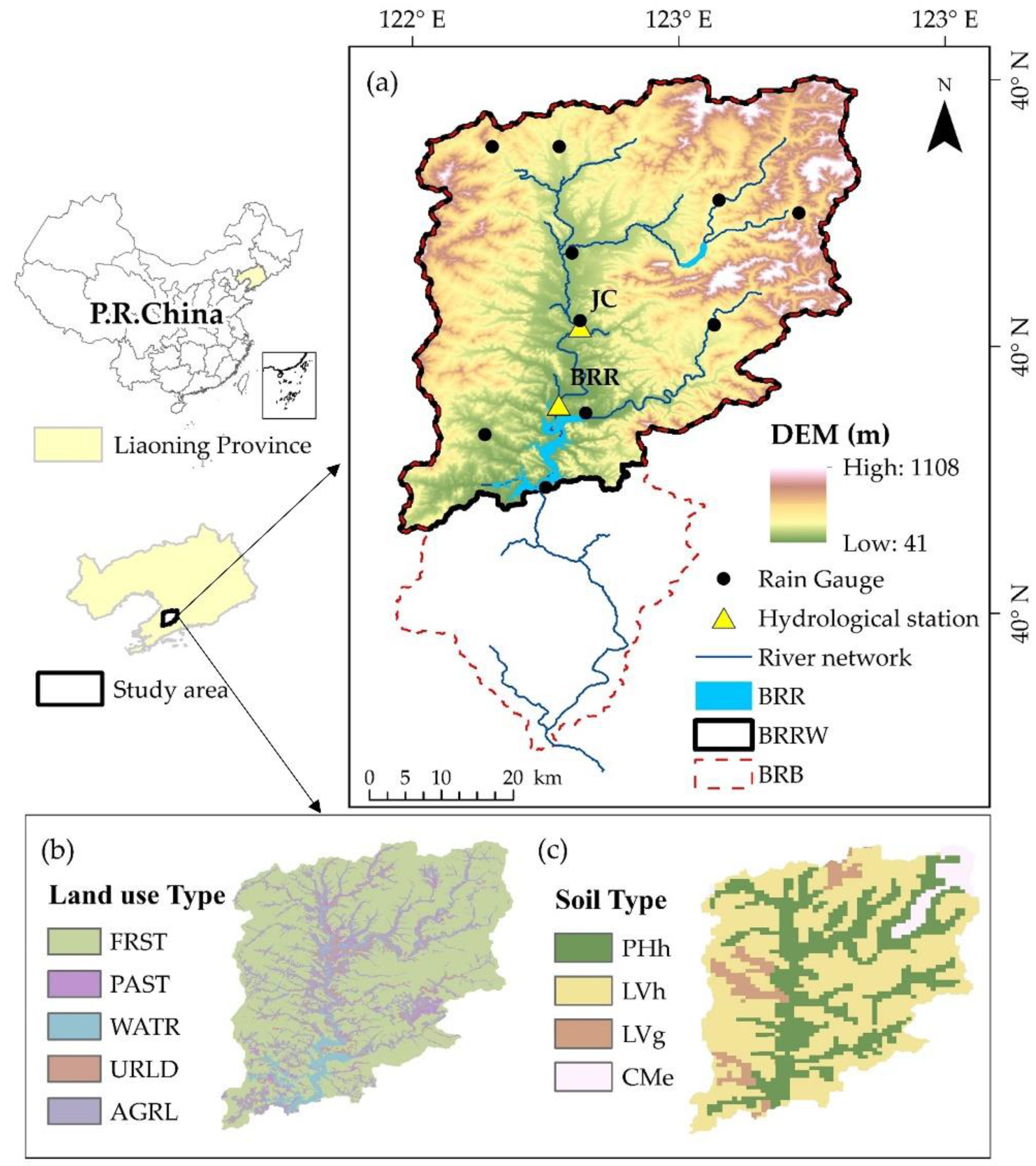
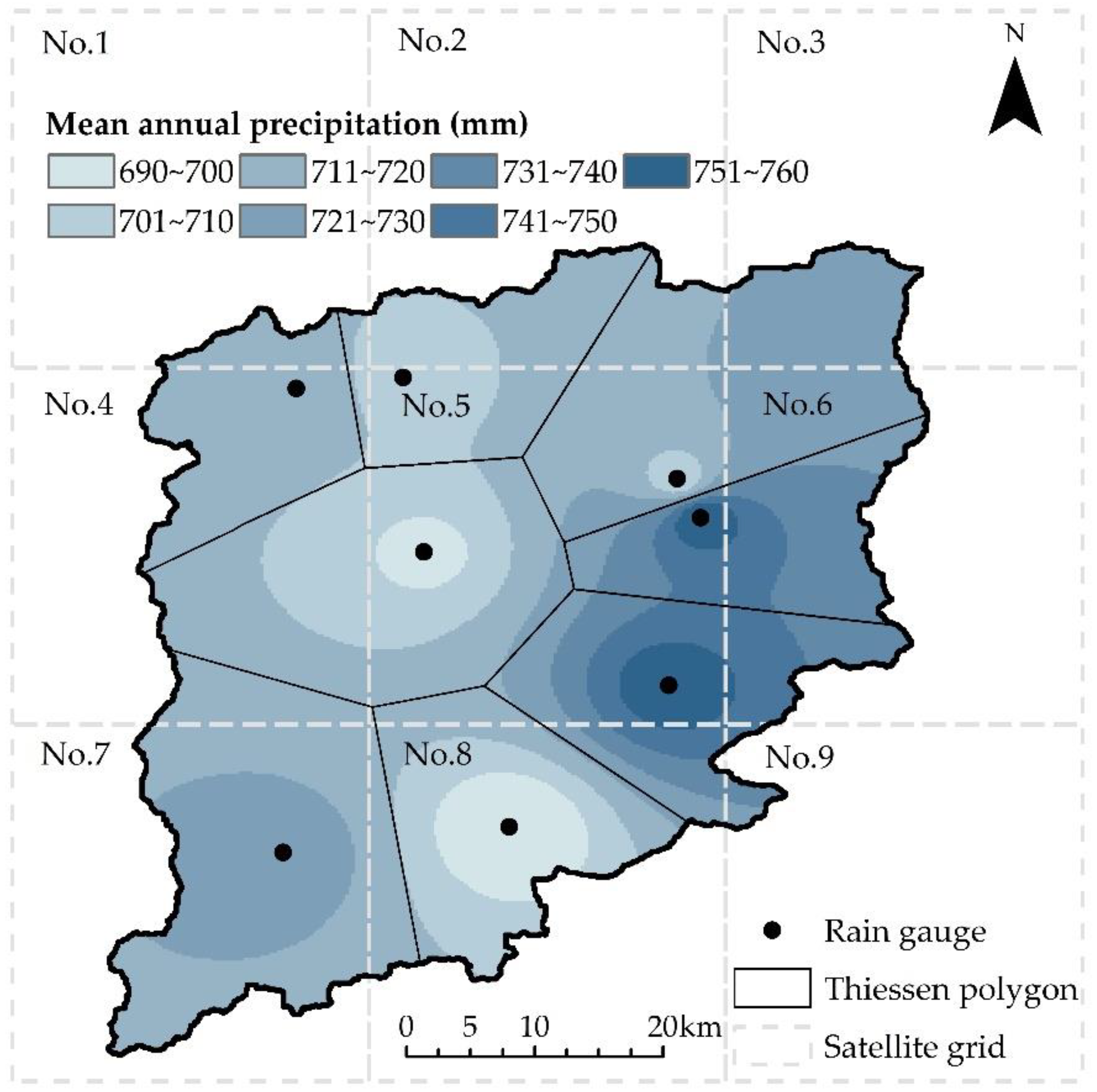
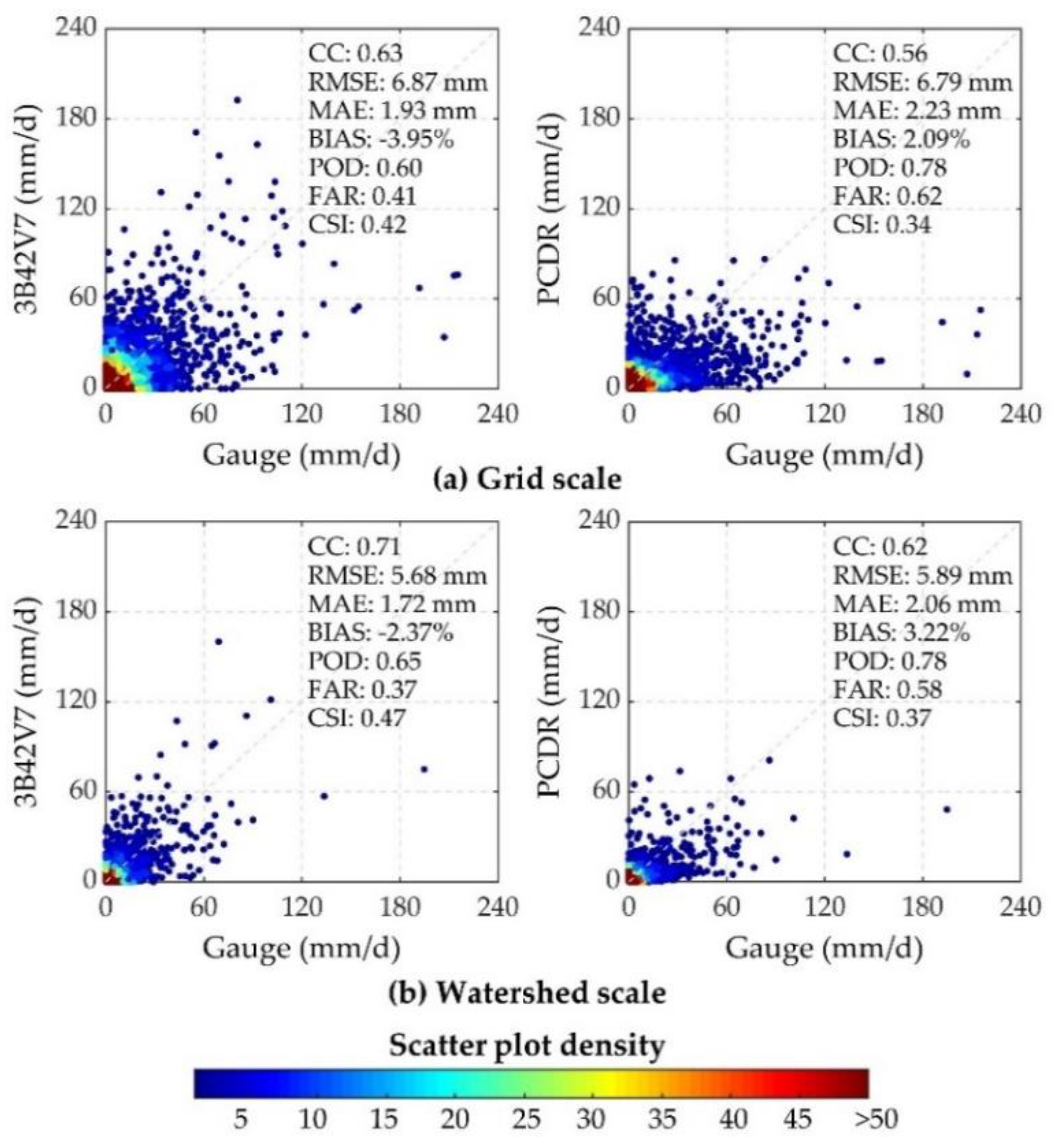
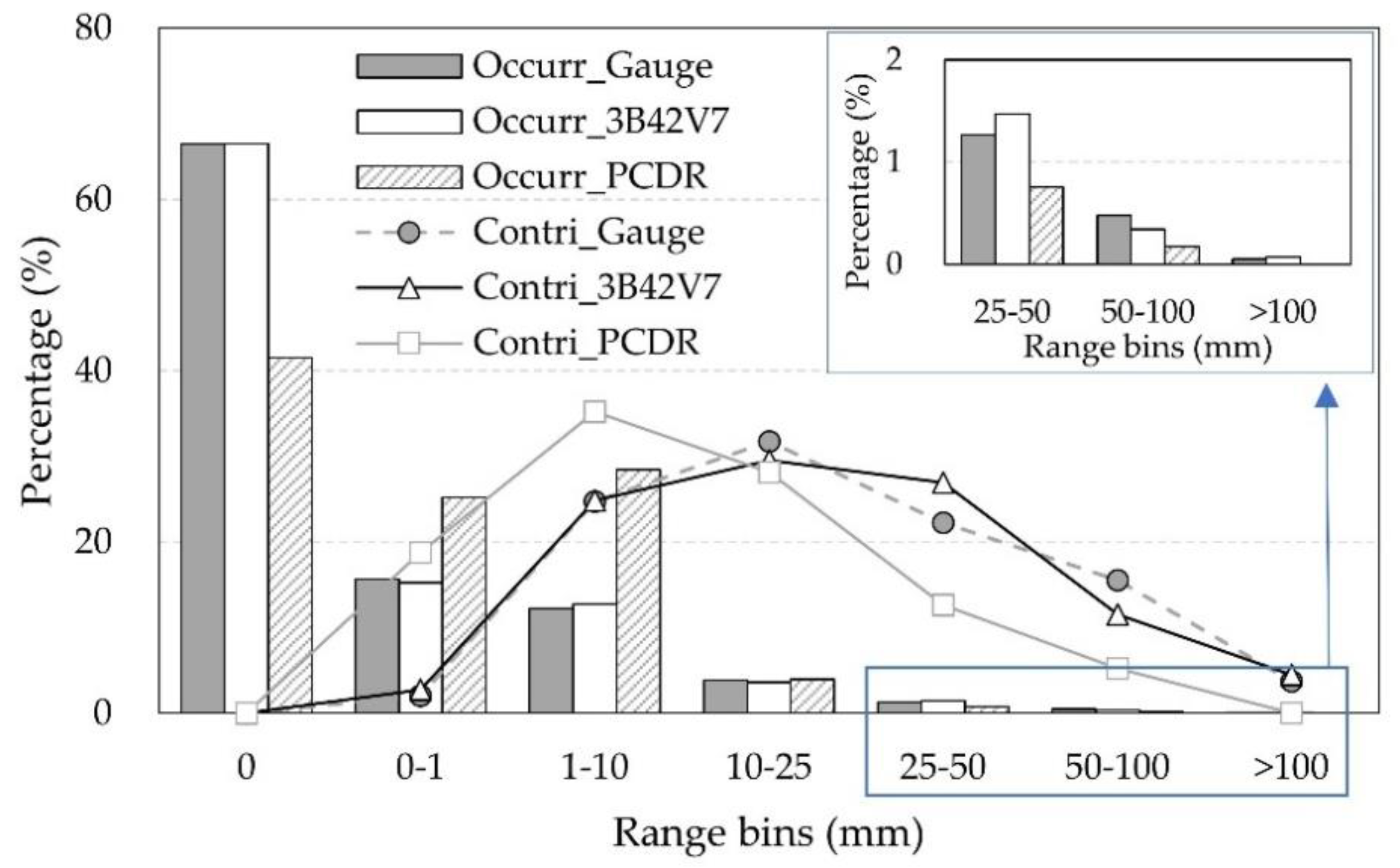
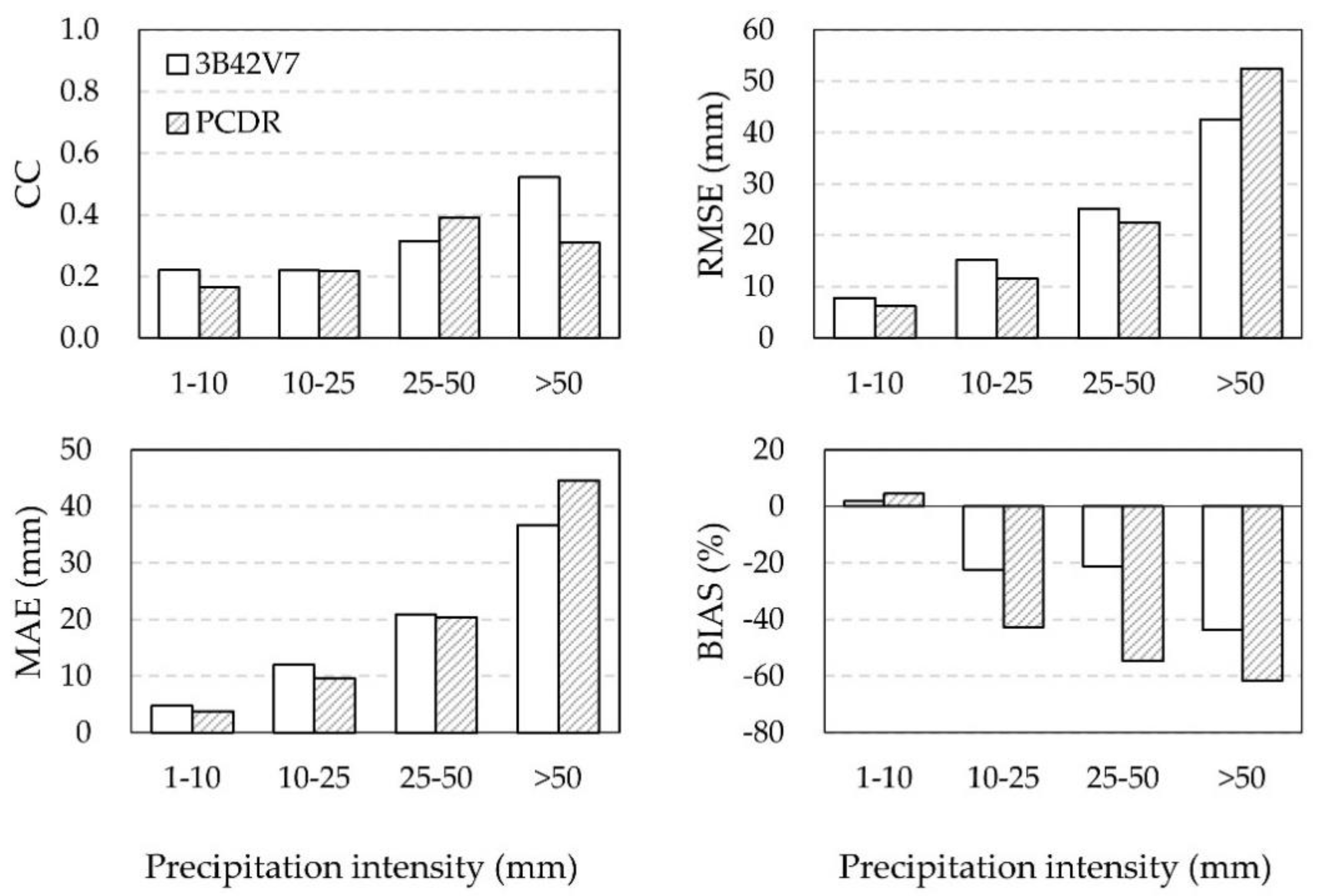
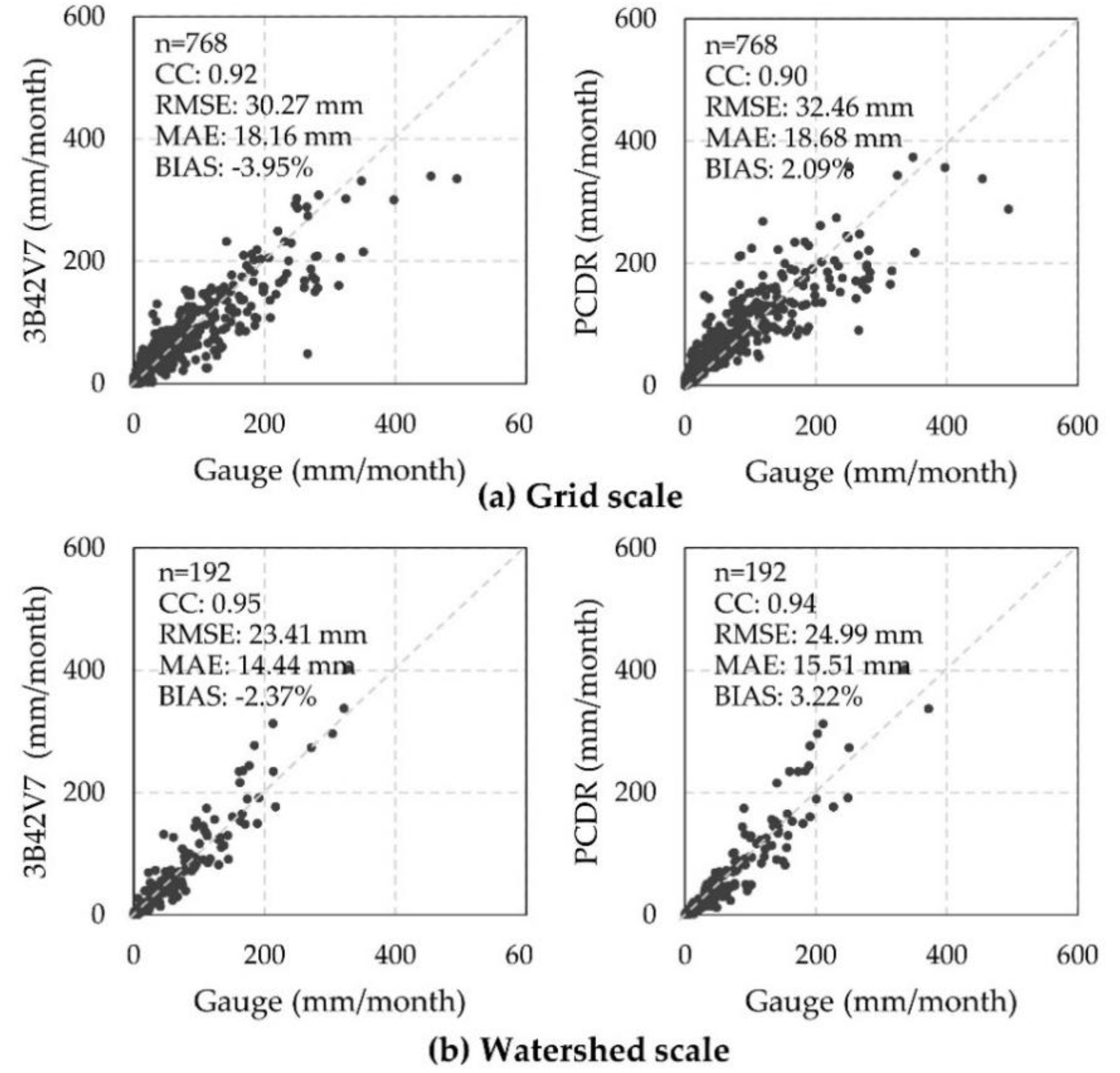
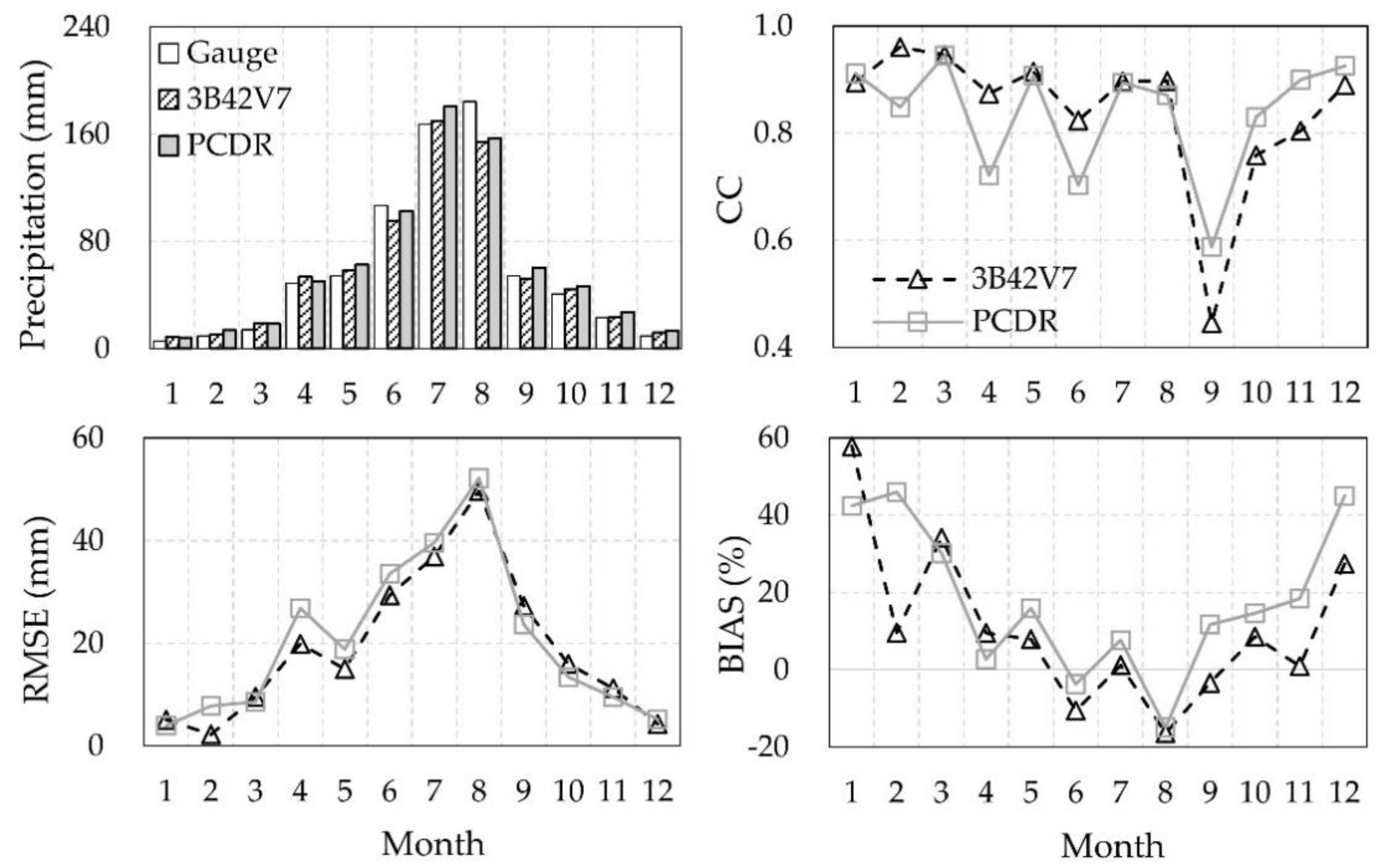
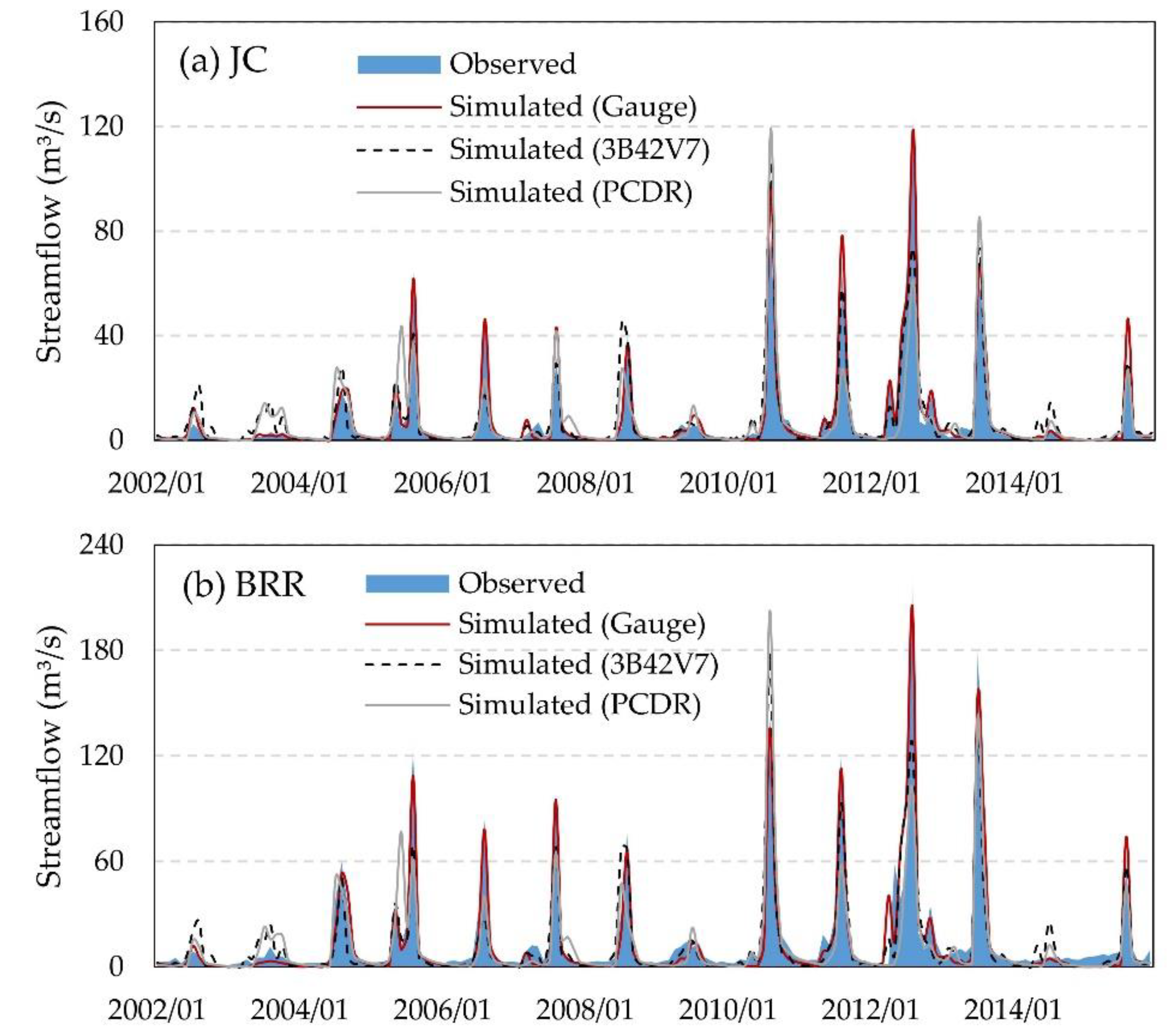
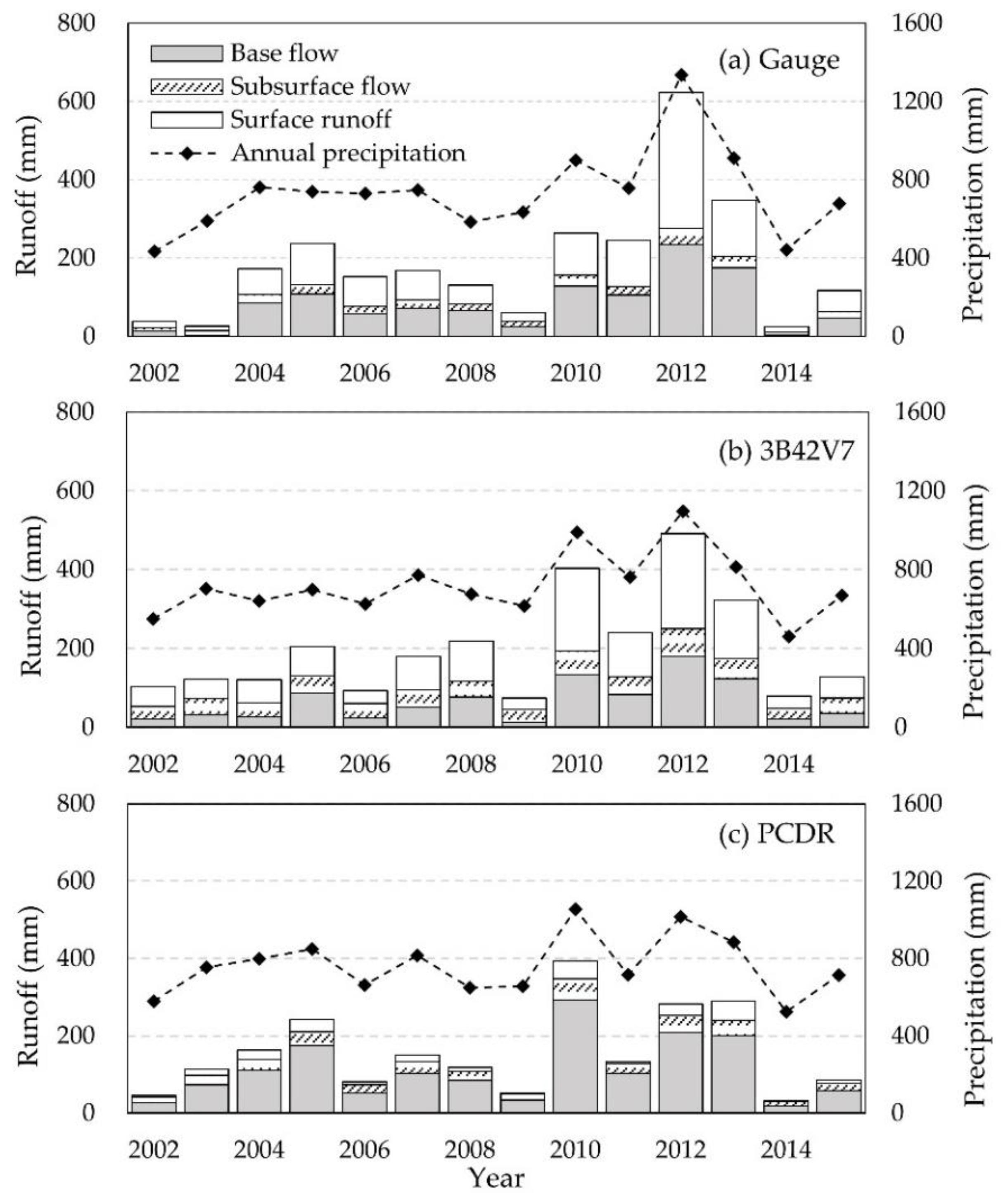
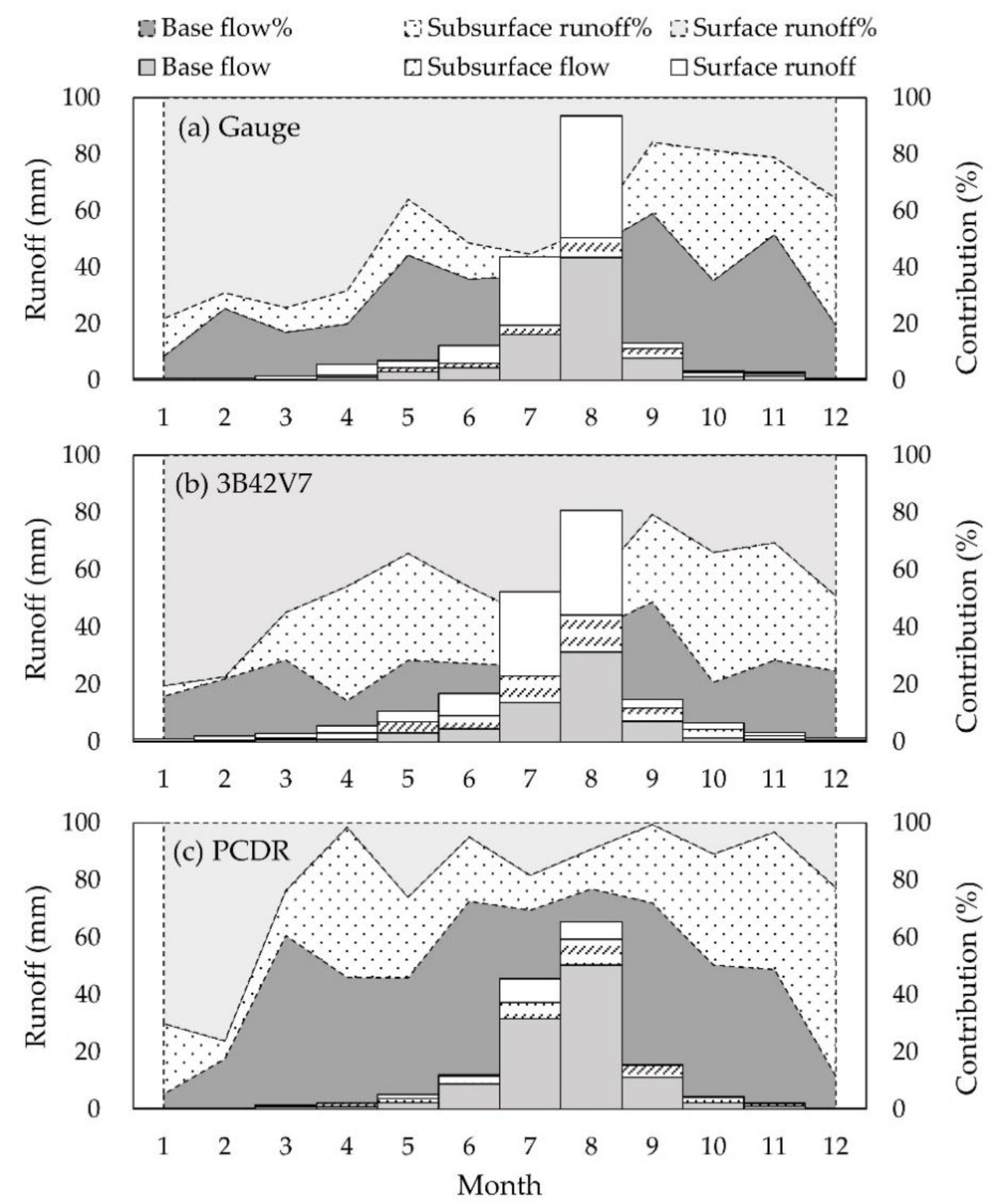
| Grid | CC | RMSE (mm) | MAE (mm) | BIAS (%) | POD | FAR | CSI |
|---|---|---|---|---|---|---|---|
| 3B42V7 | |||||||
| No.4 | 0.60 | 6.99 | 1.95 | −6.12 | 0.57 | 0.41 | 0.41 |
| No.5 | 0.66 | 6.44 | 1.89 | −3.22 | 0.58 | 0.37 | 0.44 |
| No.7 | 0.62 | 7.08 | 1.98 | −6.55 | 0.59 | 0.45 | 0.40 |
| No.8 | 0.64 | 6.94 | 1.89 | 0.30 | 0.61 | 0.41 | 0.43 |
| PCDR | |||||||
| No.4 | 0.52 | 6.95 | 2.25 | −0.30 | 0.76 | 0.62 | 0.34 |
| No.5 | 0.60 | 6.28 | 2.15 | 1.93 | 0.77 | 0.60 | 0.36 |
| No.7 | 0.58 | 7.00 | 2.28 | −0.82 | 0.79 | 0.62 | 0.34 |
| No.8 | 0.57 | 6.91 | 2.23 | 7.84 | 0.80 | 0.63 | 0.34 |
| Parameter | Lower Bound | Upper Bound | Optimal Value | Process | ||
|---|---|---|---|---|---|---|
| Gauge-Based Model | 3B42V7 | PCDR | ||||
| ESCO | 0.01 | 1 | 0.09 | 0.18 | 0.15 | Evaporation |
| EPCO | 0.01 | 1 | 0.09 | 0.07 | 0.85 | Evaporation |
| CN2 | −20 | 15 | 7.34 | 10.14 | −4.01 | Runoff |
| SOL_AWC | −0.2 | 0.2 | 0.09 | 0.01 | 0.04 | Soil |
| SOL_K | −0.8 | 0.8 | −0.49 | 0.03 | −0.26 | Soil |
| CH_K2 | 1 | 25 | 19.98 | 12.88 | 14.46 | Channel |
| CH_N2 | 0.01 | 0.1 | 0.09 | 0.10 | 0.01 | Runoff |
| RCHRG_DP | 0 | 0.5 | 0.21 | 0.14 | 0.24 | Ground water |
| GW_REVAP | 0.02 | 0.2 | 0.19 | 0.18 | 0.09 | Ground water |
| REVAPMN | 0 | 500 | 458.5 | 286.5 | 175.5 | Evaporation |
| GW_DELAY | 1 | 365 | 5.00 | 4.28 | 2.82 | Ground water |
| ALPHA_BF | 0.001 | 1 | 0.58 | 0.24 | 0.63 | Runoff |
| GWQMN | 0 | 500 | 384.5 | 141.5 | 18.5 | Ground water |
| Precipitation Dataset | Station | Period | NSE | R2 | Bias (%) |
|---|---|---|---|---|---|
| Gauge | JC | Calibration | 0.95 | 0.96 | 6.6 |
| Validation | 0.96 | 0.97 | 7.9 | ||
| BRR | Calibration | 0.95 | 0.97 | −23.3 | |
| Validation | 0.92 | 0.93 | −9.9 | ||
| TMPA 3B42V7 | JC | Calibration | 0.53 | 0.57 | 17.2 |
| Validation | 0.83 | 0.83 | 2.3 | ||
| BRR | Calibration | 0.71 | 0.73 | −22.0 | |
| Validation | 0.80 | 0.80 | −14.6 | ||
| PERSIANN-CDR | JC | Calibration | 0.43 | 0.49 | 22.3 |
| Validation | 0.68 | 0.69 | −12.5 | ||
| BRR | Calibration | 0.57 | 0.58 | −19.4 | |
| Validation | 0.73 | 0.75 | −26.4 |
| Levels | Precipitation | JC Station | BRR Station | ||
|---|---|---|---|---|---|
| Inputs | R2 | Bias (%) | R2 | Bias (%) | |
| High flow | Gauge | 0.92 | 8.1 | 0.85 | −4.0 |
| 3B42V7 | 0.63 | −13.8 | 0.54 | −21.7 | |
| PCDR | 0.38 | −22.4 | 0.44 | −28.4 | |
| Moderate flow | Gauge | 0.69 | 7.3 | 0.74 | −30.0 |
| 3B42V7 | 0.16 | 44.6 | 0.27 | −3.8 | |
| PCDR | 0.21 | 41.1 | 0.19 | −8.8 | |
| Low flow | Gauge | 0.29 | 0.5 | 0.01 | −35.7 |
| 3B42V7 | 0.16 | 73.7 | 0.01 | −37.8 | |
| PCDR | 0.27 | 57.9 | 0.04 | −40.5 | |
| Class of Frequency | Precipitation | JC Station | BRR Dtation | ||
|---|---|---|---|---|---|
| Inputs | R2 | Bias (%) | R2 | Bias (%) | |
| F ≤ 37.5% | Gauge | 0.98 | 6.1 | 0.93 | −7.4 |
| (Wet years) | 3B42V7 | 0.83 | −3.7 | 0.80 | −17.1 |
| PCDR | 0.64 | −9.7 | 0.69 | −21.0 | |
| 37.5% < F ≤ 62.5% | Gauge | 0.92 | 12.6 | 0.95 | −21.9 |
| (Normal years) | 3B42V7 | 0.54 | 10.9 | 0.75 | −29.4 |
| PCDR | 0.61 | 9.5 | 0.77 | −32.8 | |
| F > 62.5% | Gauge | 0.73 | 3.1 | 0.53 | −46.7 |
| (Dry years) | 3B42V7 | 0.34 | 102.3 | 0.30 | 17.0 |
| PCDR | 0.33 | 59.0 | 0.23 | −8.8 | |
| Components | Gauge-Based Model | 3B42V7-Based Model | PCDR-Based Model | ||||||
|---|---|---|---|---|---|---|---|---|---|
| Volume (mm/y) | P% | R% | Volume (mm/y) | P% | R% | Volume (mm/y) | P% | R% | |
| Precipitation | 731.7 | 719.9 | 762.2 | ||||||
| Evaporation and Transpiration | 538.1 | 73.5 | 530.1 | 73.6 | 571.6 | 75.0 | |||
| Groundwater recharge | 101.5 | 13.9 | 75.3 | 10.5 | 144.8 | 19.0 | |||
| Total runoff | 186.2 | 25.5 | 198.7 | 27.6 | 155.8 | 20.4 | |||
| Surface runoff | 86.1 | 46.2 | 91.0 | 45.8 | 18.1 | 11.6 | |||
| Subsurface flow | 20.3 | 10.9 | 42.7 | 21.5 | 27.7 | 17.8 | |||
| Base flow | 79.9 | 42.9 | 65.0 | 32.7 | 110.0 | 70.6 | |||
© 2020 by the authors. Licensee MDPI, Basel, Switzerland. This article is an open access article distributed under the terms and conditions of the Creative Commons Attribution (CC BY) license (http://creativecommons.org/licenses/by/4.0/).
Share and Cite
Zhang, L.; Xin, Z.; Zhou, H. Assessment of TMPA 3B42V7 and PERSIANN-CDR in Driving Hydrological Modeling in a Semi-Humid Watershed in Northeastern China. Remote Sens. 2020, 12, 3133. https://doi.org/10.3390/rs12193133
Zhang L, Xin Z, Zhou H. Assessment of TMPA 3B42V7 and PERSIANN-CDR in Driving Hydrological Modeling in a Semi-Humid Watershed in Northeastern China. Remote Sensing. 2020; 12(19):3133. https://doi.org/10.3390/rs12193133
Chicago/Turabian StyleZhang, Lu, Zhuohang Xin, and Huicheng Zhou. 2020. "Assessment of TMPA 3B42V7 and PERSIANN-CDR in Driving Hydrological Modeling in a Semi-Humid Watershed in Northeastern China" Remote Sensing 12, no. 19: 3133. https://doi.org/10.3390/rs12193133
APA StyleZhang, L., Xin, Z., & Zhou, H. (2020). Assessment of TMPA 3B42V7 and PERSIANN-CDR in Driving Hydrological Modeling in a Semi-Humid Watershed in Northeastern China. Remote Sensing, 12(19), 3133. https://doi.org/10.3390/rs12193133



